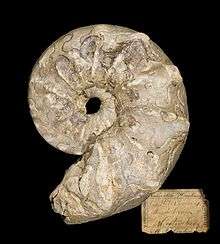Ceratites
| Ceratites Temporal range: Triassic, 251.3–221.5 Ma | |
|---|---|
 | |
| Ceratites nodosus Upper Muschelkal - Germany | |
| Scientific classification | |
| Kingdom: | Animalia |
| Phylum: | Mollusca |
| Class: | Cephalopoda |
| Subclass: | Ammonoidea |
| Order: | Ceratitida |
| Superfamily: | Ceratitaceae |
| Family: | Ceratitidae |
| Subfamily: | Ceratitinae |
| Genus: | Ceratites de Haan (1825) |
| |
Ceratites ("Horn Stone") is an extinct genus of ammonite cephalopods. These nektonic carnivores lived in marine habitats in what is now Europe, Asia, and North America, during the Triassic, from Anisian to Ladinian age. [2]
Description
This ammonite has a ceratitic suture pattern on its shell (smooth lobes and frilly saddles). Evolution of the frilly saddles is thought to be due to increased pressure on the shell, at greater depth. The frilly pattern would increase the strength of the shell and allow Ceratites to dive deeper, possibly in search of food.
Distribution
Fossils of species within this family have been found in the Triassic of Austria, Canada, China, France, Germany, Hungary, India, Israel, Italy, Pakistan, Poland, Russia, Thailand, Turkey and United States. [3]
References
- ↑ Triassic ammonoid biostratigraphy: an overview. Marco Balini, Spencer G. Lucas, James F. Jenks and Justin A. Spielmann, Geological Society, London, Special Publications 2010, volume 334, pages 221-262, doi:10.1144/SP334.10
- ↑ Sepkoski, Jack Sepkoski's Online Genus Database – Cephalopoda
- ↑ The Paleobiology Database